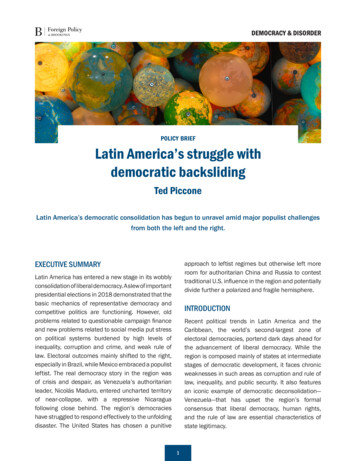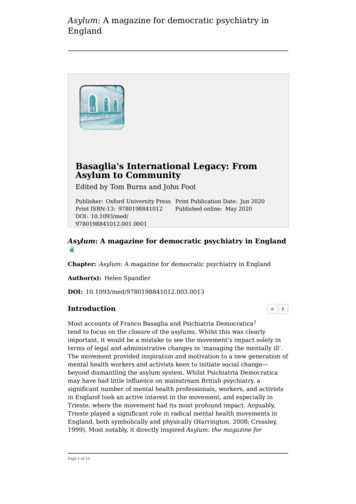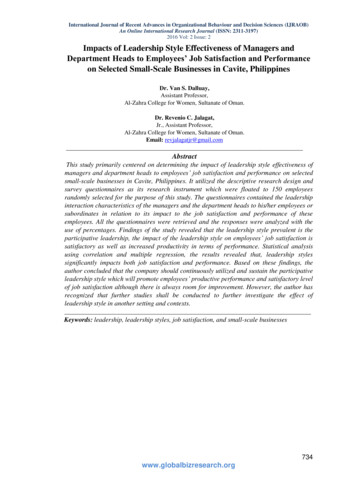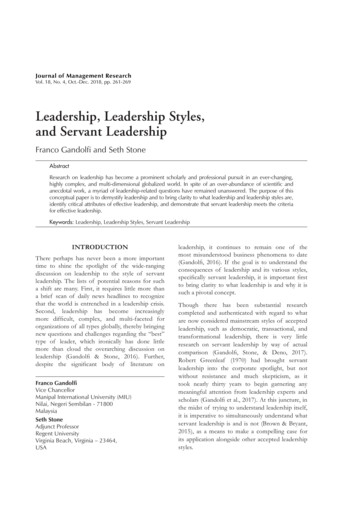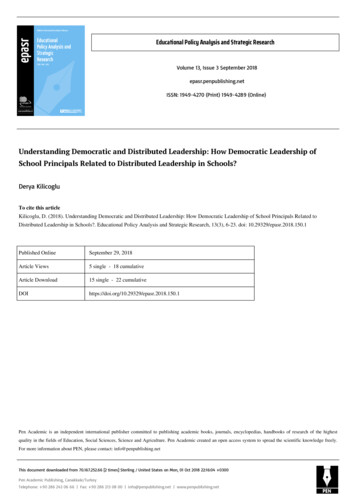
Transcription
Educational Policy Analysis and Strategic ResearchVolume 13, Issue 3 September 2018epasr.penpublishing.netISSN: 1949-4270 (Print) 1949-4289 (Online)Understanding Democratic and Distributed Leadership: How Democratic Leadership ofSchool Principals Related to Distributed Leadership in Schools?Derya KilicogluTo cite this articleKilicoglu, D. (2018). Understanding Democratic and Distributed Leadership: How Democratic Leadership of School Principals Related toDistributed Leadership in Schools?. Educational Policy Analysis and Strategic Research, 13(3), 6-23. doi: 10.29329/epasr.2018.150.1Published OnlineSeptember 29, 2018Article Views5 single - 18 cumulativeArticle Download15 single - 22 50.1Pen Academic is an independent international publisher committed to publishing academic books, journals, encyclopedias, handbooks of research of the highestquality in the fields of Education, Social Sciences, Science and Agriculture. Pen Academic created an open access system to spread the scientific knowledge freely.For more information about PEN, please contact: info@penpublishing.netThis document downloaded from 70.167.252.66 [2 times] Sterling / United States on Mon, 01 Oct 2018 22:16:04 0300Pen Academic Publishing, Canakkale/TurkeyTelephone: 90 286 243 06 66 Fax: 90 286 213 08 00 info@penpublishing.net www.penpublishing.net
Educational Policy Analysis and Strategic Research, V 13,N 3, 2018 2018 INASEDUnderstanding Democratic and Distributed Leadership: How DemocraticLeadership of School Principals Related to Distributed Leadership in Schools?Derya KılıçoğluEskişehir Osmangazi University, Eskişehir, TurkeyAbstractThe purpose of this study was to determine democratic and distributed leadership perceptions ofteachers in their school and to explore the relationship between democratic and distributed leadership.This study intended to enrich and expand scholarly reflections on democratic and distributedleadership as regards considering the association between them, thereby deepening our understandingof leadership. Correlational research design was used as a research design in the study. Studypopulation included teachers working at high schools in Eskisehir district in Turkey. Stratifiedsampling was used as a sampling method. The study sample included 462 teachers working at highschools. Descriptive statistics for democratic leadership suggested that respondent teachers perceivedemocratic leadership in their school in moderate level. Support and supervision were perceived asdistributed leadership functions of the leadership team in schools. Regarding the leadership teamcharacteristics, it was concluded that leadership teams are moderately perceived as coherent. Thestudy results also revealed that there is a strong relationship between democratic leadership,distribution of leadership functions and coherent leadership team characteristics.Keywords: Democratic leadership, distributed leadership, school principals.DOI: -Derya Kılıçoğlu, Assist. Prof. Dr., Faculty of Education, Eskişehir Osmangazi University, Eskişehir, TurkeyEmail: dderyayilmaz@gmail.com6This document downloaded from 70.167.252.66 [2 times] Sterling / United States on Mon, 01 Oct 2018 22:16:04 0300
Educational Policy Analysis and Strategic Research, V 13,N 3, 2018 2018 INASEDIntroductionThe idea that leadership need to be distributed to be most effective in enhancing learning inschools gains a powerful momentum in leadership studies. In order to increase student learning,creating a culture of sharing responsibility and leadership in schools, not merely among schoolmembers but collectively within the community, plays an important role (Louis, Leithwood, Wahlstrom, & Anderson, 2010). Even though school leaders are key agents to promote students in receivinglearning opportunities and to sustain continuous improvement in schools, the traditional view of aleader has been changing. Leaders at the organizational apex are not believed as the unique sources ofchange and vision in school organizations (Woods, 2005). New tendencies for leading and managingschools are asserted to be based on shared responsibilities of all members of the learning communityin participative environments (Delgado, 2014). Since school improvement is difficult to be performedmerely by school leaders, meaningful involvement of students, teachers, and parents in planning orimplementation processes is necessary. It cannot be assumed that school improvement could bemeaningfully succeeded and sustained only by the efforts of the school leaders. Democraticapproaches of leadership (Gunter, 2001; Harris et al., 2003) have been proposed to address thechallenges that the schools face with (Delgado, 2014).In schools where democratic approaches are embraced, all school members engage to work asa team in the decision making, implementation or monitoring processes, and sense of ownership isdeveloped with the participation of all school members. Therefore, democratic schools can easily copewith the challenges that the schools are facing by exceeding the capabilities of individual leadersthrough the participation of all school members. By means of using democratic approaches, decisionmaking authority is spread throughout the school by providing all school members opportunity toparticipate in key decisions in schools (Delgado, 2014). Shared, collective and democratic leadershipapproaches have been addressed as the most affective approaches for providing responsibilities to leadand manage change and school improvement.Distributed leadership where two or more individuals are in the practice of the principalship ispointed as an example of democratic leadership (Woods, 2005). It is assumed that distributedleadership fits within the collective and democratic approaches (Delgado, 2014). Indeed, distributedleadership emerged as an alternative to charismatic leadership, which portrays super talentedcharacteristics with a single figure that persuade, inspire or direct followers towards the goals oforganizational success (Hartley, 2007; Woods, 2005), is believed to be more likely to have aninfluence on student outcomes compared to traditional top-down leadership (Bell, Bolam & Cubillo,2002, Silins & Mulford, 2002). Distribution of leadership roles and responsibilities is asserted to beassociated with improvement of pupil outcomes and development of students as human beings andactive participants (Day et al., 2009; Kensler, 2010; Woods, 2011).Distributed leadership also7This document downloaded from 70.167.252.66 [2 times] Sterling / United States on Mon, 01 Oct 2018 22:16:04 0300
Educational Policy Analysis and Strategic Research, V 13,N 3, 2018 2018 INASEDenables change in educational performance and organizational culture (Avissar, Alkaher & Gan,2017). In this context, distributed leadership is asserted to open up the boundaries of leadershipbeyond those in formal leadership positions and challenge hierarchies in school organizations. It isalso indicated that distributed leadership is effectively performed in schools where an atmosphere oftrust, collegiality and cooperation exist. Indeed, the schools in the communities with democratic valuesand devolution of power will provide a sound ground for adoption of distributed leadership (Saadi,Hussain, Bhutta, Perveen, Kazmi & Ahmad, 2009).There are several empirical investigations of democratic and distributed leadership that helprefine the theory and shed light on educational leadership literature. Even though the distinctiveness ofdemocratic leadership in comparison with distributed leadership is delineated (Woods, 2004), thesetwo leadership styles or approaches are related in the broadest sense like Spillane and Sherer (2004)noted as “scholars and practitioners often use shared leadership, democratic leadership and distributedleadership interchangeably, suggesting that, at least for some, distributed leadership may be no morethan a new label for a familiar phenomena” (p.3). While in some cases, these terms are usedinterchangeably, some scholars describe those terms differ in meaning by trying to indicate finedistinctions (Oduro, 2004). Even though there is considerable attention to these leadership approaches,it is obvious that there is a definitional problem is further evident in the leadership literature and it issuggested that distributed leadership is the repackaging of familiar leadership concepts (Lakomski,2005; Storey, 2004). There is therefore a need to understand how distributed and democraticleadership are interrelated.The purpose of this study is to determine democratic and distributed leadership perceptions ofteachers in their school and to explore the relationship between democratic and distributed leadership.The questions that guided the research were twofold: How do teachers perceive democratic and distributed leadership in schools? What is the relationship between democratic and distributed leadership in schools?From this point of view, this study intended to enrich and expand scholarly reflections ondemocratic and distributed leadership as regards considering the association between them, therebydeepening our understanding of leadership.Democratic LeadershipDemocratic leadership has flowed in popularity throughout the history of education andrepackaged numerous times by the educational theorists and researchers (Klinker, 2006). Indeed, theideas about democratic leadership developed in the late 1930s, experiment undertaken by Kurt Lewin8This document downloaded from 70.167.252.66 [2 times] Sterling / United States on Mon, 01 Oct 2018 22:16:04 0300
Educational Policy Analysis and Strategic Research, V 13,N 3, 2018 2018 INASEDand Ronald Lippitt in the United States. In the experiment, three groups of school children operatedunder three differential leadership styles: authoritarian, democratic and laissez-faire. The authoritarianleader offers clear expectations about what will be done, when and how. All decisions are taken byauthoritarian leader with minimum input from other group members. The democratic leader offersguidance to group members with participating in the group and encouraging member involvement indecision making while laissez-faire leader offers little or no guidance to group members with leavingall decision-making up to group members. Each three group took place in common activity project inthe experiment and democratic leadership found as the most effective of the three leadership stylesregarding the fact that group members feel more engaged and motivated, work together morecooperatively and creatively. However, the members in the authoritarian group were found as lesscreative, more dissatisfied and uninvolved. Similarly, the members in laissez-faire group were foundas the least productive showing little cooperation and satisfaction (Rustin & Armstrong, 2012). As inthe experiment, it is clear that democratic leadership facilitates leaders’ and others’ growth towardhuman potential (Woods, 2005). Indeed, the heart of democratic leadership rests a respect for what isto be human, a sense of cultivation of the common good, and the individual freedom to act accordingto one’s direction (McClain, Ylimaki & Ford, 2010). Therefore, democratic leadership created anenvironment in which people are encouraged and supported in aspiring to truth in an open-hearted way(Woods, 2005, p.xvi).Democratic leadership is concerned with meaningful participation and decision making toestablish conditions for respectful relationships, collaborative associations, active cooperation, andenable the formation of social, learning and culturally responsive educational organizations, in part byemploying strategies for achievement, enabling particular conversations and struggling to determinewhat is needed, when, and how to get there in specific situations by developing a politically informedcommitment to justice for all (Gale & Densmore, 2010). It is also necessary to state that “democraticleadership entails rights to meaningful participation and respect for and expectations toward everyoneas ethical beings” (Woods, 2004, p.4).Democratic leadership based on philosophical tradition of Dewey’s pragmatism cultivates “anenvironment that supports participation, sharing of ideas, and the virtues of honesty, openness,flexibility and compassion” (Starratt, 2001, p. 338). Indeed, democratic leadership implies that schoolprincipals are responsible to build educational organizations around central democratic values such assupporting equity and social justice, as well as in the wider community. It emphasizes social justice,dignity, rights and welfare of minorities and all individuals in the school. Democratic leadershiprequires value base of leadership practice and the processes creating or sustaining social justice,empowerment and community (Harris, Moos, Møller, Robertson & Spillane, 2007; Møller, 2003). Bymeans of balancing power and trust in leadership and management areas of the school, empowerment9This document downloaded from 70.167.252.66 [2 times] Sterling / United States on Mon, 01 Oct 2018 22:16:04 0300
Educational Policy Analysis and Strategic Research, V 13,N 3, 2018 2018 INASEDcan be achieved which in turn creates a stimulating learning environment where students develop ascitizens (Harris, et al., 2007).Educational administration studies of democratic school leadership have frequently focused onhow principals show democratic behaviors, use cooperative relationships and shared decision makingin schools to improve schools, and some of the research emphasized the relationship between someorganizational variables (Adeyemi & Adu, 2013; Bhatti, Maitlo, Shaikh, Hashmi, & Shaikh, 2012;Blasé & Blasé, 1997; Blasé, Blasé, Anderson & Dungan, 1995; Bozdoğan & Sağnak, 2011; Harris &Chapman, 2002; Mbera, 2015; Riley, 2003; Terzi & Derin, 2016; Yörük & Kocabaş, 2001).Distributed LeadershipDistributed leadership has come to prominence in school management and leadershipdiscourse as means to provide teachers participation and empowerment in schools (Torrance, 2013).School leaders may not accomplish all the leadership tasks alone in the school and request for supportfrom school staff because it is clear that “the common ideal of a heroic leader is obsolete [ ] the taskof transforming schools is too complex one person to accomplish single handedly” (Lashway, 2003, p.1). Therefore, school leaders have to run the school with multiple leaders to perform all leadershipfunctions, allow teachers to participate in decision making processes and enhance mutualreinforcement (Gronn, 2002; Leithwood, Mascall, Strauss, Sacks, Memon & Yashkina, 2007; WaiYan Wan, Hau-Fai Law & Chan, 2017). Since large schools with task complexity and large amount ofschool members may lead to limited daily interaction of school staff, traditional view of schoolleadership is left in favor of distributed leadership (Gronn, 2002).There is variety of meanings attached to the concept of distributed leadership in leadershipliterature (Bennett, Wise, Woods & Harvey, 2003; Woods, 2004). This favored notion is defined asemergent property of a group or network of interacting individuals in which group members pool theirexpertise (Gronn, 2002; Woods, Bennett, Harvey & Wise, 2004). Indeed, distributed leadershiphighlights a multi-faceted leadership, involving both formal and informal leadership positions(Torrance, 2013). As Harris affirms that leadership “is shared and collected endeavor that engages allmembers of the organization” (2003, p.75), distributed leadership challenges the traditional trait ofindividualistic leader. Distributed leadership is noteworthy in that it is enacted collaboratively as twoor more leaders engage in a particular situation (Spillane, 2006). Specifically, leadership that isdistributed among all school staff provides multiple leaders, formally recognized or not, practice in awide range of leadership and management activities in schools (Spillane, Halverson & Diamond,2004). Following the same line of thought, distributed leadership is “a shared process of enhancing theindividual and collective capacity of people to accomplish their work effectively” (Yukl, 2002, p.432).10This document downloaded from 70.167.252.66 [2 times] Sterling / United States on Mon, 01 Oct 2018 22:16:04 0300
Educational Policy Analysis and Strategic Research, V 13,N 3, 2018 2018 INASEDIn regard to the origin of distributed leadership, it was pointed out that there is atendency to move away from the heroic leadership style to an approach focusing on distribution ofleadership among school staff due to questioning the “single leadership” paradigm and the complexityof school leaders’ tasks (Bush & Glover, 2003; Goleman, 2002; Harris, 2004; Hartley, 2007). Indistributed leadership perspective, leadership is not considered as a school leader’s characteristic,knowledge or skill, rather it is regarded as a process based on daily interactions or functions ofmultiple leaders in the school and the situation, including organizational routines, structures and tools(Spillane, 2005; Spillane et al., 2004). As Spillane (2006) asserted that distributed leadership isstretched over a number of individuals and based on expertise, rather than hierarchical authority(Bennett et al., 2003; Woods et al., 2004). Indeed, distributed leadership provides a way of thinkingabout the practice of school leadership (Gronn, 2002; Spillane et al., 2004). As Bolden (2004)elaborates distribution of leadership is a less formalized model of leadership, separated from theorganizational hierarchy, provides individuals at all levels leadership influence and roles, as cited inOduro (2004). Thus, the responsibilities for leadership functions can be distributed on multiple leadersworking in a coordinated manner (Heller & Firestone, 1995; Spillane, 2005) Existing scholarshipshows that the core functions of leadership are necessary to be distributed. Leadership functionsinvolves setting directions and articulating a school vision, developing and stimulating teachers,monitoring and evaluating teachers’ performance (Hulpia, Devos & Rosseel, 2009, Spillane, 2005).By distributing leadership functions to other people in the school, the workload of school leaders isexpected to decrease (Hulpia & Devos, 2009).The mainstay of the literature regarding distributed leadership appears to focus oneducational organizations (Baloğlu, 2011; Currie, Lockett & Suhomliinova, 2009; Gosling, Bolden &Petrov, 2009; Gunter, Hall & Bragg, 2013; Harris, 2008; Leithwood, Mascall & Strauss, 2009,Özdemir, 2012; Spillane, 2006; Williams, 2011). These is evidence to show that where school staffwork collaboratively and leadership responsibilities are distributed, teachers’ expectations, morale,confidence, professional development, stimulation and enjoyment in schools are enhanced (Court,2003; Hulpia & Devos, 2009). Furthermore, distribution of leadership contributes to schooleffectiveness and improvement (Harris, Muijs & Crawford, 2003; Harris et al., 2007; Silins &Mulford, 2004). Distributed leadership also enhances teachers’ job satisfaction since workingcollectively foster the teachers’ feelings about being valued and supported in schools (Ereş &Akyürek, 2016; Hulpia & Devos, 2009). In addition, distributed leadership is asserted as potentialcontributor to positive change and transformation in schools (Harris et al., 2007), as well as enhancingorganizational trust, organizational support and school success (Ereş & Akyürek, 2016; Yılmaz &Turan, 2015).11This document downloaded from 70.167.252.66 [2 times] Sterling / United States on Mon, 01 Oct 2018 22:16:04 0300
Educational Policy Analysis and Strategic Research, V 13,N 3, 2018 2018 INASEDMETHODStudy DesignThe aim of this study was to explore the relationship between democratic and distributedleadership from teachers’ point of view. Correlational research design was used to test whetherdemocratic leadership of school principals is related to distributed leadership in schools.ParticipantsStudy population included teachers working at high schools in Eskisehir district in Turkey.Stratified sampling was used as a sampling method in the study. The study sample included 462teachers working at high schools. Different type of 22 high schools included in the sample wasdetermined regarding their socio economic environment. Based on the information obtained fromteachers and Eskişehir Provincial Directorate of National Education, the high schools were separatedinto three groups: lower, middle and upper layers. Of the selected high schools, 9 of them wereAnatolian high school, 6 of them were one of them was social sciences high school, 3 of them werehigh school and 4 of them were science high school, social sciences high school, İmam Hatip highschool and teacher training high school. Of the respondent teachers, men (n 240) and women (n 217)were close in number and their ages were between 25 and 62 years (M 41.72, SD 8.28). Greatmajority of the sample (80.3%) hold the degree of Bachelor of Arts and the average work experienceof the participants was 18.48 years. Demographic characteristics of the study sample were presented inTable 1.Table 1. Demographic characteristics of the study 1-10 823.456 eprogram(Ph.D.)71.530 2This document downloaded from 70.167.252.66 [2 times] Sterling / United States on Mon, 01 Oct 2018 22:16:04 0300456*98.7442*
Educational Policy Analysis and Strategic Research, V 13,N 3, 2018 2018 16.211.310.45.048.797.4Note. * There are missing parts in the data collection tool that participants did not answer all the items.Data Collection ToolsThe data of the study were collected through two scales. The first one was Leadership StyleQuestionnaire, which was used to determine democratic leadership style of school principals. Thesecond one was Distributed Leadership Inventory (DLI), which was used to identify distributedleadership in the school, based on the teachers’ view. Moreover, demographic characteristics of theparticipants were collected via specific questionnaire items.Leadership Style QuestionnaireLeadership Style Questionnaire developed by Northouse (2011) was administered onparticipants in the study. The questionnaire provides three subscales with 18 items measuringautocratic, democratic and laissez faire leadership styles. Since the present survey emphasized ondemocratic leadership styles of school principals, only the subscale measuring democratic leadershipstyle was used. Democratic leadership subscale of the questionnaire comprised of six items. Afteradaptation of the questionnaire into Turkish language, Confirmatory Factor Analysis (CFA) was usedto determine construct validity of the scale. The CFA results revealed acceptable goodness of fitindices ( χ2 36.09, df 9, χ2/ df 4.27, RMSEA .09, AGFI .91, GFI .97, SRMR .034) whichindicate that the scale items fit the collected data (Hu & Bentler 1998; Jöreskog & Sörbom 2001;MacCallum, Browne & Sugawara 1996). Furthermore, the reliability of the current study was analyzedand the Cronbach Alpha coefficient was found as .87, which shows an acceptable internal consistency,as shown in Table 2.Distributed Leadership Inventory (DLI)Distributed Leadership Inventory (DLI) developed by Hulpia and her colleagues (2009). Theinventory comprised two parts focusing on distributed leadership functions of the members of theleadership team and characteristics of the leadership team. Leadership functions past of the inventoryidentify whether supportive leadership behavior and supervising are achieved in the school leadershipteam. Leadership team characteristics emphasize a clear management framework characterized bygroup cohesion. Leadership functions were measured by 13 scale items with two sub-scales (supportand supervision) while leadership characteristics were measured by 10 scale items.13This document downloaded from 70.167.252.66 [2 times] Sterling / United States on Mon, 01 Oct 2018 22:16:04 0300
Educational Policy Analysis and Strategic Research, V 13,N 3, 2018 2018 INASEDConfirmatory factor analyses were conducted to confirm the underlying two-componentstructures for the leadership functions of the leadership team and one-component structure ofleadership team characteristics. The first CFA was carried out on the items corresponding to theleadership functions. The analysis assure that the two-factor model of the leadership functionsrevealed good model fit results ( χ2 252.47, df 60, χ2/ df 4.20, RMSEA .09, AGFI .87,GFI .91, SRMR .027). The second CFA was conducted on the items corresponding to thecharacteristics of the leadership team. The one-factor model of the leadership team characteristics wasfit for the scale and indicated acceptable goodness of fit indices ( χ2 169.32, df 30, χ2/ df 5.64,RMSEA .10, AGFI .87, GFI .93, SRMR .021). The two CFA indicated that the scale items fit thecollected data (Hu & Bentler 1998; Jöreskog & Sörbom 2001; MacCallum, Browne & Sugawara,1996).The reliability of the scores of the DLI was determined through Cronbach’s alpha coefficient.The scores of the coherent leadership team characteristics had a high internal consistency (α .98).The internal consistencies of the leadership functions were as follows: support scale scores were high(α .96) and the scores of the supervision scale had high reliability coefficient (α .95) as well, asshown in Table 2.Table 2. Fit statistics for confirmatory factor analysis and cronbach alpha values2Model χ2 df χ / dfGFIAGFISRMRRMSEAαDemocratic upervision.95DLI-Leadership a AnalysisDescriptive statistics such as mean and standard deviation were used in the study to determinedemocratic and distributed leadership in schools. Pearson correlation analysis was conducted todetermine the correlation between democratic and distributed leadership. Path analysis was usedthrough structural equation modeling to test developed theoretical model which asserts that democraticleadership is related to distributed leadership in schools. IBM SPSS Statistics 20 and LISREL 8.7software were used for statistical analyses in the study.14This document downloaded from 70.167.252.66 [2 times] Sterling / United States on Mon, 01 Oct 2018 22:16:04 0300
Educational Policy Analysis and Strategic Research, V 13,N 3, 2018 2018 INASEDFindingsThe mean, standard deviations, and the correlation coefficients between democratic anddistributed leadership are presented in Table 3. Descriptive statistics for democratic leadership suggestthat respondent teachers perceive democratic leadership in their school in moderate level (M 3.43;SD .78). Descriptive statistics also showed that support (M 3.38; SD 1.07) and supervision (M 3.47; SD 1.11) are perceived as distributed leadership functions of the leadership team in schools.Indeed, the results suggested that supervision is more equally distributed among the leadership teamthan support according to the respondents. Regarding the leadership team characteristics, it wasconcluded that leadership teams are moderately perceived as coherent (M 2.97; SD .91).Before testing the theoretical model which investigates the relationship betweendemocratic and distributed leadership, Pearson correlation was conducted to determine the correlationbetween democratic and distributed leadership in schools. As seen in Table 3, positive relations,ranged between moderate to strong, were found between democratic leadership, leadership functionsand leadership characteristics of distributed leadership.Table 3. Means, standard deviations, and correlation coefficients between democratic and cratic csNote. * Correlation is significant (p .01)Path analysis was conducted to determine the correlations between variables by calculating thegoodness of fit indices for the developed model. The goodness of fit indices of the theoretical modelwhich are presented in Table 4 determined with GFI, AGFI, SRMR, RMSEA, Δχ2 and Δχ2 / Δdf ratiostatistics. GFI, AGFI, SRMR and RMSEA goodness of fit values were considered as the indicationthat the theoretical model was suitable for the obtained data (Hoyle, 2012; Hu & Bentler 1998;Jöreskog & Sörbom 2001; MacCallum et al., 1996).15This document downloaded from 70.167.252.66 [2 times] Sterling / United States on Mon, 01 Oct 2018 22:16:04 0300
Educational Policy Analysis and Strategic Research, V 13,N 3, 2018 2018 INASEDTable 4. Goodness of fit statistics for the theoretical model2Model χ1418.942 df χ / dfGFIAGFISRMRRMSEA1093.84.90.86.060.08The results of the path analysis conducted on the theoretical model to determine thecorrelation between democratic and distributed leadership are presented in Figure 1. The first part andthe independent variable of the model of structural equation designed between democratic anddistributed leadership, the democratic leadership scale included 6 observed variables. The second partand the dependent variable of the structural equation mode
challenges that the schools face with (Delgado, 2014). In schools where democratic approaches are embraced, all school members engage to work as a team in the decision making , implementation or monitoring processes, and sense of ownership is developed with the participation of all school members. Therefore, democratic schools can easily cope
